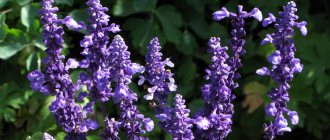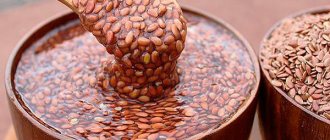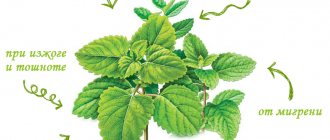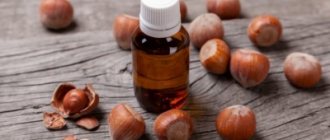Breastfeeding is natural, but not the only way to feed a child. For many reasons, a mother may decide to change her breastfeeding routine for her baby. Not only when transitioning to solid foods, but also for work or comfort reasons.
The reasons why a mother decides to stop breastfeeding can vary. Some mothers may decide to do this when they return to work, other mothers find it too painful or difficult to feed and decide not to do it. Regardless of the reason, their body, even after stopping breastfeeding, continues to produce the milk necessary to feed the baby.
What are the benefits of sage
It is generally accepted that breastfeeding should be completed smoothly. This concerns not only the gradual weaning of the baby from the breast, but also the health of the woman herself. After all, breastfeeding does not always end only due to lack of milk. In such cases, sage is recommended for women. In addition to other medicinal substances, the plant contains phytoestrogen, a sex hormone of plant origin, almost an analogue of the female one. It compensates for the lack of estrogen that forms in the female body when breastfeeding, thereby reducing milk production and promoting the complete cessation of lactation.
The plant also has the following beneficial properties:
- Anti-inflammatory.
- Antibacterial.
- Diuretic.
- To a small extent, but a pain reliever.
Sage will also help eliminate the unpleasant consequences of the completed breastfeeding process, which is often accompanied by lactostasis or mastitis. It will relieve pain, remove excess heaviness in the chest and have an anti-inflammatory effect. You will need to take drinks based on the beneficial plant for approximately 3 or 4 days to achieve maximum results.
Effect of sage on milk production
Sage has long been used to reduce lactation. As mentioned above, at the end of the breastfeeding period, the plant helps reduce milk production and avoid the use of hormonal drugs. This happens because sage during breastfeeding affects the hormonal balance in the female body. The phytoestrogens it contains affect prolactin, which in turn stops lactation. The healing plant will help not only reduce the volume of milk, but also alleviate the physical condition of a woman, for example, sage leaves prevent high temperatures and excessive breast engorgement.
How to stop lactation?
The choice of drug to stop lactation depends on the factors leading to milk production. The main one, of course, is related to hormonal levels. Milk secretion is influenced by pituitary hormones, and in particular estrogen and prolactin. They are interconnected. Therefore, to influence prolactin, it is necessary to influence estrogen.
Most often, women try to achieve this with the help of pills, which is quite risky. Any drug can disrupt the overall hormonal balance, which has never led to a positive outcome. Side effects from the nervous, cardiovascular system, and digestive tract cannot be discounted. Therefore, it is allowed to touch medications only after careful coordination of this issue with the doctor and the absence of other options.
Sage is considered one of the simplest and safest options for solving lactation problems. Along with peppermint or fragrant mint, it has been used for many decades. The result is visible almost immediately. After 1-2 days, changes in the condition of the breast appear. After a couple of weeks, the lactation process slows down significantly or ends completely.
But you can’t take anything thoughtlessly, even if it’s a folk remedy. So the main task of a young mother is to understand how sage works, how to brew this herb and use it so as not to get the side effects that any drug has.
Benefits of a useful plant
Sage is a natural and natural medicine, as evidenced by even its name of the same name, “officinalis sage.” It is not allowed to drink it during lactation, unless this is the final stage of breastfeeding. Sage leaves are the first of the folk remedies that help reduce or completely reduce lactation. This plant contains about three percent of beneficial essential oils, which have a bactericidal and anti-inflammatory effect.
Plus, the plant has the following properties:
- has a rejuvenating effect,
- relieves physical stress and eliminates psychological burnout due to illness,
- helps cope with sore throat or bronchitis,
- relieves inflammation on the skin and gums,
- effective in the treatment of kidneys and skin diseases,
- restores memory and normalizes brain activity.
Before using the plant, you should pay attention to the possibility of developing an allergic reaction, since those substances that were familiar to the body before childbirth can provoke signs of an allergy after it. Due to the enormous changes in hormones, you should be extremely careful when consuming sage.
How and in what form to use sage when breastfeeding
To reduce lactation, sage is used in the form of decoctions, teas, infusions, or applied as compresses. Drinks based on this plant slowly and surely fulfill their main task, reducing lactation without much harm to the female body.
The amount of drink depends primarily on the volume of breast milk that needs to be stopped. In terms of time, only the maximum limit is defined, no more than three months. But on average, if you consume sage several times a day, you will need to drink it for several weeks.
The essential oil is more concentrated, compresses with it help stop lactation in almost a couple or three days.
Tea
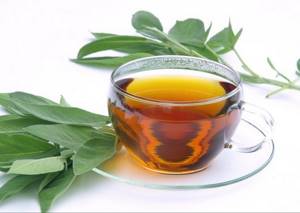
Preparing sage-based tea is no different from regular black tea; a few tablespoons of the crushed herb are poured with boiling water, brewed and drunk up to three times a day, about half a glass. Ready-made tea bags can be purchased at the pharmacy. They are brewed for about 5 minutes, and you can drink a whole cup up to six times a day. The taste of the plant is not entirely pleasant, so those who have a sweet tooth can flavor their tea with honey or add a little sugar.
Decoction
For a medicinal decoction, leaves or inflorescences of the plant itself are used. To prepare yourself, you should take care of supplies during flowering or wait until September. The healing potion is prepared as follows: pour two tablespoons of the plant with boiled water and infuse. Then filter and take a few sips 2-3 times during the day.
Infusion
Sage tincture contains alcohol, but is much more effective than other drinks. The rapid action of an alcohol infusion is possible only with a complete cessation of breastfeeding, since alcohol and breastfeeding are incompatible things. The infusion is consumed 30-60 drops in 5-6 approaches per day, not in pure form, but diluted with water. Additionally, you can take a tincture based on walnut leaves or hop cones.
Extract
Due to its high efficiency, the extract is also used in diluted form up to three times a day, 1 ml. In addition to drinking to stop lactation, it is used in cosmetology, since sage extract accelerates hair growth and improves the condition of the skin. In no case should an overdose of the remedy be allowed, because it is much richer than an alcohol solution.
Essential oil
This represents the maximum concentration of sage; use only five drops up to 3-4 times a day. The duration of administration reaches 3-4 days, after which the milk disappears almost completely.

If the end of breastfeeding is accompanied by heaviness or bloating of the breasts, compresses with oil help well. To do this, gauze is soaked in a mixture of vegetable oil and oils of sage, mint, geranium, cypress and placed on the chest. Or you can replace the gauze with cabbage leaves and use only sage oil. In addition to the milk-stopping effect, such a compress has an anti-inflammatory effect.
The use of sage to stop lactation
Breastfeeding mothers try to stop the production of breast milk in various ways. One of the effective methods is the use of sage.
Important tips for stopping breastfeeding
The need to stop lactation arises for various reasons: the mother’s health, the child’s refusal to breastfeed, etc. Pediatricians advise feeding a newborn with breast milk for at least 1 year.
The process of completing lactation can cause some problems, so you should listen to the recommendations:
- Weaning does not break the close relationship between mother and child. There comes a point when milk is replaced with vitamins and nutrients from other foods.
- A process initiated by the mother may be difficult for the child to perceive. It will take a lot of patience and time before the child's body gets used to the changes.
- Do not suddenly stop feeding. Gradually reducing the number of times your baby latches to the breast will benefit both of you. It is not recommended to bandage the breasts, as such actions can cause mastitis. To relieve discomfort, apply a cold compress or ice. You can express a small amount of milk if your breasts are very full. It is important not to provoke new milk production by such actions.
- It is recommended to skip 1 feeding and offer the baby to drink expressed milk from a bottle. You can also use a sippy cup or small cup.
- The baby can ask for the breast without feeling hungry. It is recommended to distract his attention with games or a walk.
- Breastfeeding mothers sometimes give breastfeeding to their baby, wanting to soothe him. You can improve your newborn's mood in other ways (hug, read a book, sing a song).
- To reduce the time. If the baby is attached to the breast for 5 minutes, stop feeding after 3 minutes. You can offer permitted fruit as a snack.
- The child drinks little, and the amount of milk does not decrease. In this case, it is recommended to reduce the amount of liquid consumed to a minimum. You should not take too hot a shower. To reduce pain, it is recommended to apply chilled cabbage leaves to the chest.
- You should teach your child to fall asleep while eating. After lunch, you can take a walk outside so that your newborn learns to fall asleep on his own. When putting your child to bed in the evening, you can turn on slow music, read a fairy tale, and put your favorite toys in bed. After some time, the newborn will get used to the new ritual.
- Wean your child off night snacks and set him up for uninterrupted sleep. If he wakes up at night, you should not give him the breast. It is best to rock the baby in your arms and sing a lullaby. You can offer to drink water.
- Once you are determined to stop lactation, you cannot give up when you hear a baby crying. It is recommended to be close to the child and try to comfort him. The mother's confidence and calmness are transferred to the child.
The child may not be ready for drastic changes. You should not start this process if the newborn is sick. If there is no urgent need, weaning can be postponed for a while.
Pros and cons of sage
Sage is used more often than other plants during breastfeeding due to the large number of active components. It includes:
- essential oil, the main ingredients of which are pinene, rhodine, cineole, camphor and thujone;
- flavonoids;
- tannins;
- tannins;
- organic acids;
- carotene;
- resinous compounds;
- vitamins (A, B, C, PP);
- minerals (iron, zinc, sodium, potassium, magnesium, calcium).
Products prepared from this plant are used for the following purposes:
- to reduce breast milk production;
- disinfection;
- strengthening the stomach;
- reducing mucus accumulation;
- reducing sweating;
- accelerated scar healing.
The plant has anti-inflammatory, expectorant and astringent effects. It promotes conception and prevents the development of cancer. The body's protective properties are strengthened, and a feeling of calm appears due to the sedative properties of the plant.
The anti-lactation effect of sage is based on the phytoestrogen present in its composition. The use of this plant promotes the active production of estrogen. A high content of this gene in the blood leads to a sharp drop in prolactin levels. Without this hormone, milk production is impossible.
Products prepared from the plant are harmless (in the absence of contraindications). Disadvantages include the appearance of negative symptoms due to long-term use of herbal remedies. You can drink sage only after consulting a specialist, because in some cases unpleasant symptoms occur:
- stomach ache;
- noise in ears;
- increased heart rate;
- dizziness;
- nausea.
If such consequences occur, you should stop using herbal remedies.
Rules for taking to reduce lactation
Sage to stop lactation (how to take):
- The need to stop milk production may occur even if this product is the main source of nutrition for the child. In this case, the doctor prescribes special medications, and herbal infusions will only be an additional remedy.
- If the baby needs breastfeeding only at night, there is no need to quickly stop lactation. The plant will help to gradually reduce milk production and wean the newborn from the breast.
When using herbal remedies to suppress lactation, you should not expect quick results. The hormone contained in the plant does not act as effectively as estrogen.
Rules for taking herbal remedies:
- The procedure should begin after the child reaches 1 year, because at this age it is easier for him to switch to other foods.
- The course should begin after some feedings have been replaced with complementary foods.
- The amount of fluid consumed (including herbal infusions) should be halved. It is not recommended to drink drinks that are too hot.
- Once you start using herbal remedies, you should not breastfeed your baby. It is recommended to express milk (not often). First, perform this procedure after 1 day, then after 3 days.
- Compresses help relieve fever resulting from inflammation. If there is no improvement, you should seek medical help.
It is recommended to lead an active lifestyle and exercise, as increased sweating reduces milk production. How many days the final process will last depends on the individual characteristics of the female body.
Sage is also used in its pure form during lactation. The crushed plant is added to fruit or vegetable juice. The effect of this plant will be noticeable within 4 days. Milk will stop flowing in, its production will tend to decrease.
Decoctions
Decoctions help get rid of the feeling of fullness in the chest and prevent the appearance of lumps in it. This remedy is used to gradually wean the baby from the breast.
We recommend that you read: Use of sage during pregnancy
Ingredients:
- leaves of the plant - 7 g;
- water - 250 ml.
Cooking technology:
- Chop the leaves, add boiling water and place in a water bath.
- Cook covered over low heat for 10 minutes.
- Remove from heat, wrap in a towel and let steep for 2 hours.
- Strain the finished drink through several layers of gauze.
It is recommended to take 1 tbsp up to 4 times a day. l. before eating. The product not only reduces the amount of milk and eliminates breast discomfort, but also reduces pain during menstruation.
The decoction is useful not only for internal use. It can be used to apply compresses to the nipple area to reduce the amount of milk produced, but this method requires long-term use.
The infusion also helps solve the problem. To prepare it, pour boiling water (½ l) over the herb (1-2 tbsp) and let it brew in a thermos for 20 minutes. Once cooled to room temperature, the drink can be taken orally. This infusion can replace part of the liquid consumed during the day.
You can prepare the grass yourself at the beginning of flowering and in September. The flowering tops of the plant and leaves are used. In pharmacies, the herb is sold dried or in the form of tablets or capsules. Consuming them during breastfeeding will help quickly complete milk production. Before taking the tablets, it is recommended to read the instructions.
Tinctures for breastfeeding
You can buy a ready-made tincture in pharmacies, but due to the alcohol content, you should not put the baby to the breast after consuming it. To prepare the product you will need the following ingredients:
- alcohol tincture - 50-60 drops;
- chilled boiled water - 1 glass.
Combine the components and take the resulting product throughout the day.
Sachets
The herb can also be sold in bags. This form is convenient to use. The drink infuses faster because the leaves in the bags are crushed. The disadvantage is the low efficiency of the drink compared to decoction and oil.
Before using the plant, you should learn how to brew sage to stop lactation:
- Empty your breasts (feed your baby or express milk).
- Pour boiling water (1 glass) over the grass (2 filter bags) and let it brew.
- Use when cooled.
The maximum daily intake is 500 ml. It is recommended to drink the drink in small portions throughout the day. As a result of taking it, the heaviness in the chest will gradually disappear, because the amount of milk produced will decrease.
The duration of use is about 1 or 2 weeks. To get quick results, it is recommended to combine tea with compresses and oil.
You should carefully monitor your condition and stop taking the medication after milk production has completely stopped.
The plant has a bitter taste, so it is recommended to add honey, sugar or other sweeteners to drinks.
Extracts
The extract is more effective than alcohol tincture. The substance should be dissolved (1 ml) in a small amount of water and taken 3 times a day. Care must be taken not to overdose.
We recommend that you read: Corn during breastfeeding
Compresses for breastfeeding
Such procedures will not eliminate lactation, but will help prevent the appearance of lumps in the breast. In this case, both the plant itself and the oil made from it are used. A few drops of the substance should be applied to cotton wool or gauze and applied to the breast, without touching the nipples and areolas.
To prepare a more effective product, you will need the following ingredients:
- sage oil - 2 drops;
- mint oil - 2 drops;
- geranium oil - 2 drops;
- cypress oil - 2 drops;
- vegetable oil - 25 g.
Mix all ingredients. Moisten gauze in the resulting mixture and apply to the area where inflammation has formed. The compress should be kept for about 2-3 hours. The effectiveness of compresses is due to the content of a large number of phytohormones in essential oils, which affect the production of prolactin. This hormone is responsible for milk production.
Compresses are a preventative against various diseases of the mammary glands.
If you have lumps, it is recommended to consult a mammologist before using homemade products. In some cases, emergency medical care is required, including surgery.
Oils
Sage oil is widely used to stop lactation, since this composition contains the largest amount of useful substances. It is recommended to take 5 drops 4 times a day. The average duration of use is 4 days. To reduce pain, it is recommended to use compresses. Apply a few drops of oil to cabbage leaves and apply to the mammary glands.
Possible contraindications
The use of sage to reduce lactation is contraindicated in the following cases:
- epilepsy;
- diseases of the thyroid gland, accompanied by a weakening of its functions;
- pyelonephritis;
- high blood pressure;
- pregnancy;
- chronic bronchitis, cough in the acute stage;
- inflammatory diseases of the reproductive system;
- the presence of tumors (both malignant and benign);
- remission after cancer of the uterus and mammary glands;
- individual intolerance.
A nursing woman taking herbal preparations should regularly check the baby's skin for allergic reactions. The duration of use should not exceed 3 months, since the phytoestrogens that make up the plant gradually accumulate in the body and can cause severe poisoning.
Dr. Komarovsky
Advice from E. O. Komarovsky (pediatrician) on safe weaning of a child:
- Separate mother and child for 2-3 days. The option is complex (morally) and is therefore rarely used.
- Limit the amount of liquid.
- Reduce sucking time as much as possible (distract the child, play with him).
- Don't pump.
- Be active in sports.
- Avoid consuming foods that stimulate lactation (for example, beer).
You can worsen the taste of milk by including garlic or other similar products in your diet. The use of herbs to solve this issue is a more gentle method, because...
Taking medications affects your health. The chemical composition of the drugs negatively affects the condition of the heart, kidneys, liver and gastrointestinal tract.
The pills also affect a woman’s emotional state, causing fatigue and depression.
Source: https://alltravnik.ru/travy/shalfej-i-laktaciya

